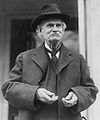The 20th congressional district of Ohio was created after the 1840 census. It was eliminated in the redistricting following the 1990 census, and redistricted and renumbered as the 10th district.

Texas's 12th congressional district in the United States House of Representatives is in the north portion of the state of Texas. As of 2017, the 12th district contained 806,551 people and had a median income of $67,703. It consists of the western half of Tarrant County, as well as most of Parker County. The district also contains Texas Christian University. Fragments of the Dallas–Fort Worth metroplex are included in the district. The district is currently represented by Republican Kay Granger, who was first elected in 1996.
Louisiana's 6th congressional district is a congressional district in the U.S. state of Louisiana. Located in south-central Louisiana, the district contains most of the state capital of Baton Rouge, the bulk of Baton Rouge's suburbs, and continues south to Thibodaux. It also includes the western shores of Lake Pontchartrain.
Louisiana's 8th congressional district is a defunct congressional district and no longer exists after Louisiana lost its eighth congressional seat in the 1990 U. S. Census. For its entire existence, it was based in Alexandria and included much of the north-central part of the state.
South Dakota's 2nd congressional district is an obsolete district. It was created after the 1910 census and was eliminated as a result of the redistricting cycle after the 1980 Census. Members were elected at-large until the formation of individual districts after the 1910 census. From 1913 until 1933, the 2nd district covered much of northeastern South Dakota, including the cities of Aberdeen, Brookings, Huron, and Watertown. When South Dakota's 3rd congressional district was eliminated after the 1930 census, the 2nd district was relocated to cover all of the counties in South Dakota west of the Missouri River. Population changes eventually moved the district's boundaries further east. During the 97th Congress, it covered all but the 21 easternmost counties in the state.

Florida's 7th congressional district is a congressional district in the north central portion of the U.S. state of Florida.
Ohio's 10th congressional district is represented by Representative Mike Turner (R). The district is based in southwestern Ohio and consists of Montgomery County, Greene County, and a portion of Clark County.

The 16th congressional district of Ohio is an obsolete United States congressional district last represented by Representative Anthony Gonzalez (R). It was last located in the northeast of the state, covering Wayne County and with arms extending north into the suburbs of Cleveland, and east into Greater Akron and Stark County. The district was eliminated upon the swearing in of the 118th United States Congress on January 3, 2023, as the reapportionment after the 2020 census reduced the number of congressional districts in Ohio to fifteen.
South Dakota's 1st congressional district is an obsolete congressional district that existed from 1913 to 1983.
Pennsylvania's 31st congressional district was one of Pennsylvania's districts of the United States House of Representatives. It existed from 1903 to 1953.

Pennsylvania's 19th congressional district was a congressional district that became obsolete for the 113th Congress in 2013, due to Pennsylvania's slower population growth compared to the rest of the nation.
Missouri's 5th congressional district has been represented in the United States House of Representatives by Democrat Emanuel Cleaver, the former Mayor of Kansas City, since 2005.
Mississippi's 3rd congressional district (MS-3) covers central portions of state and stretches from the Louisiana border in the west to the Alabama border in the east.
Michigan's 18th congressional district is an obsolete United States congressional district in Michigan. The first Representative to Congress elected from the 18th district, George Anthony Dondero, took office in 1953, after reapportionment due to the 1950 census. In 1933, Dondero had previously been the first representative elected from 17th district.
Mississippi's 5th congressional district existed from 1855 to 2003. The state was granted a fifth representative by Congress following the 1850 census.
Mississippi's 7th congressional district existed from 1883 to 1953. It was created after the 1880 census and abolished following the 1950 census.
Mississippi's 6th congressional district existed from 1873 to 1963. It was created after the United States 1870 census and abolished following the 1960 census, due to changes in population.
The U.S. state of Mississippi's at-large congressional district existed from December 10, 1817, when it was admitted to the Union until 1847, when representatives were elected in districts.
Alabama's at-large congressional district was a congressional district for the United States House of Representatives in Alabama active at various times from 1819 to 1965. Alabama became a state in 1819, and its single representative to the 16th and 17th Congresses was elected at-large. For the 27th Congress, all five of Alabama's representatives were elected at-large, before the state gained a representative from the 1840 census. In the 43rd to 44th Congresses, the seventh and eighth representatives gained in the 1870 census were elected at-large. For the 63rd and 64th Congresses, Alabama elected the tenth of its apportioned representatives, gained in the 1910 census, at-large from the entire state. For the 88th Congress, after the state lost one representative in the 1960 census, Alabama once again elected all of their representatives at-large.
Alabama's 10th congressional district is an obsolete district which existed from 1917 until 1933. Its sole representative was William B. Bankhead.





